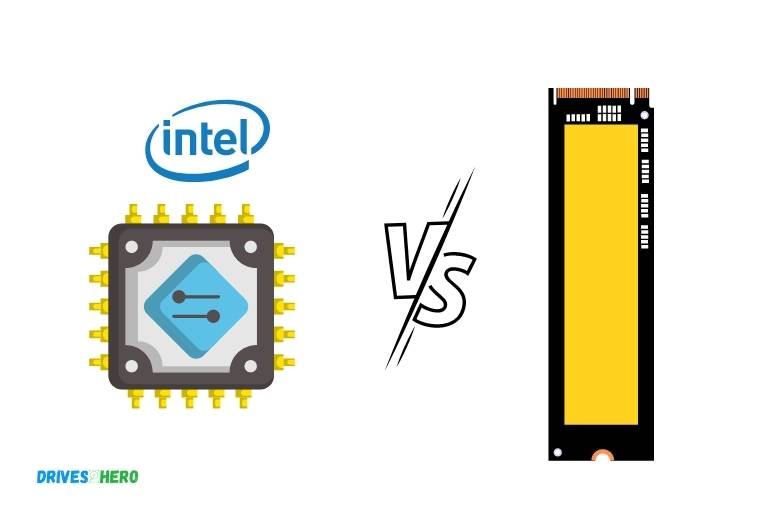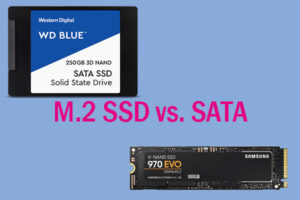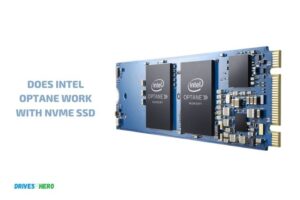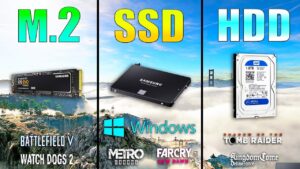Intel Optane Memory Vs Nvme Ssd
Intel Optane Memory and NVMe SSD are both cutting-edge storage technologies that offer significant improvements over traditional HDDs and SATA-based SSDs.
However, their primary differentiation lies in their capabilities, performance, and target users.
Intel Optane Memory is specifically designed as a cache memory solution that accelerates the performance of traditional HDDs and SATA SSDs.
It uses Intel’s 3D Xpoint technology, which offers lower latency and faster data access compared to NAND-based SSDs.
On the other hand, NVMe (Non-Volatile Memory Express) SSDs are a storage solution that offers superior performance, lower latency, and increased power efficiency compared to traditional SSDs.
NVMe SSDs use the PCI Express (PCIe) interface for faster data transfer speeds, making them ideal for high-performance computing tasks.
Intel Optane Memory:
NVMe SSD:
In summary, Intel Optane Memory and NVMe SSD both offer advantages over traditional HDDs and SATA SSDs in terms of performance and latency.
However, Intel Optane Memory primarily functions as a cache for accelerating existing storage devices, while NVMe SSDs provide an overall superior storage solution that excels in high-performance computing tasks.
13 Features: Intel Optane Memory Vs Nvme Ssd
| Feature | Intel Optane Memory | NVMe SSD |
|---|---|---|
| Storage Technology | 3D XPoint | NAND Flash |
| Interface | PCIe NVMe 3.0 x2 or x4 | PCIe NVMe 3.0 or 4.0 x4 |
| Form Factors | M.2 | M.2, U.2, AIC (Add-in card) |
| Capacity | 16GB, 32GB, 64GB | 128GB to 8TB (varies by model) |
| Sequential Read Speed | Up to 2,400 MB/s (depending on model) | Up to 7,000 MB/s (depending on model) |
| Sequential Write Speed | Up to 2,000 MB/s (depending on model) | Up to 6,800 MB/s (depending on model) |
| Random Read IOPS | Up to 550,000 IOPS | Up to 1,000,000 IOPS (depending on model) |
| Random Write IOPS | Up to 500,000 IOPS | Up to 1,000,000 IOPS (depending on model) |
| Latency | < 10 µs | < 20 µs (typical) |
| Endurance (TBW) | Up to 365 TBW (for 64GB version) | Varies, up to 3,000 TBW+ |
| Power Consumption | Around 3.5W (Active) / ~1W (Idle) | Varies, around 6W (Active) / ~2W (Idle) |
| Price | $$ (higher cost/GB ratio) | $ (lower cost/GB ratio) |
| Use Case | System acceleration, caching | Primary storage, high-performance workloads |
Key Takeaway

Five Facts About Intel Optane Memory Vs Nvme Ssd
Understanding The Differences Between Intel Optane
Beginning to understand Intel Optane’s features and capabilities requires exploring the distinctions between the various models. Intel Optane memory is a type of memory that uses advanced 3D XPoint technology to increase system performance and responsiveness.
Memory And Nvme Ssd
Solid state drives (ssds) have become increasingly popular for their fast processing speed and reliable output.
With newer technologies such as intel optane memory and nvme ssds, it can be challenging to know the best option for your computer.
These two technologies have significant differences in terms of function, speed, and performance.
Benefits Of Using Solid-State Drives
- Faster processing time and excellent boot speed
- Improved durability and shock resistance compared to traditional hard drives
- Reduced energy consumption, leading to cost saving
- Improved computer performance
How Intel Optane Memory Differs From Nvme Ssd
Intel optane memory and nvme ssds are different in terms of the way they function and operate.
Intel optane memory is more like a caching drive, while nvme ssds are designed to provide primary storage. The primary difference between these two technologies is the way they handle data.
Differences In Speed And Performance
Nvme ssds offer high speed and performance that provide excellent primary storage, which means they are more suitable for large files, such as games and graphics.
Although intel optane memory is not as fast, it provides high-speed read and write capabilities, making it suitable for day-to-day use such as web browsing, video playback, and office applications.
Advantages And Disadvantages Of Using Intel Optane Memory And Nvme Ssd
Advantages of using intel optane memory:
- Improved responsiveness, making it suitable for everyday tasks
- High-speed read and write capabilities
- Cost-effective compared to nvme ssds
Disadvantages of using intel optane memory:
- Limited storage capacity
- Not as fast as nvme ssds
Advantages of using nvme ssd:
- Fast processing and boot speeds
- Large storage capacity
- Suitable for gaming and high-end graphics use
Disadvantages of using nvme ssd:
- Expensive compared to intel optane memory
- May not be needed for everyday users who don’t require high-end performance capabilities
While intel optane memory and nvme ssds are both excellent choices for users looking to upgrade their computer’s performance, understanding the differences in the way they function, operate, and handle data is vital in determining which one is best suited for your needs.
Intel Optane Memory Explained
Intel Optane Memory is a form of solid-state memory designed to speed up access times to frequently used data on a PC, making system operations faster and smoother.
What Is Intel Optane Memory?
Intel optane memory is a type of memory technology created by intel.
It is a non-volatile memory that is faster and more efficient than traditional hard drives, making it an excellent solution for users who need faster storage.
It works by using high-capacity storage that acts as a buffer between ram and storage drives, resulting in a speedier performance for devices.
How It Works
Intel optane memory works like a smart caching system. When you launch an application or a file, chunks of the data are stored on the intel optane memory module for quick and efficient access.
When you launch the same application or file again, the chunks of data that were stored in the optane memory are pulled from it and loaded into the ram instantly, resulting in a faster and smoother performance.
This process allows users to quickly move to more storage-intensive applications and cut down on boot and app loading times.
Advantages And Disadvantages Of Using Intel Optane Memory
Using intel optane memory comes with several advantages that make it a viable solution for many users. However, it also has its downsides.
Here are some of the advantages and disadvantages of using intel optane memory:
Advantages:
- Faster storage transfer speeds
- More responsive application performance
- Faster boot and load times
- Cost-effective solution for upgrading older systems
- Power-efficient performance
Disadvantages:
- Small size (compared to traditional ssds)
- Limited compatibility with some systems
- Not ideal for transferring large files
- May not offer a significant performance boost for some systems
- Pricier than traditional hard disk drives.
Nvme Ssd Explained
Intel optane memory and nvme ssd are two of the most popular storage solutions in the market today. While both are solid options, each has its own strengths and weaknesses that make them unique.
In this post, we’ll dive deep into nvme ssd and explore what makes it such a valuable option for your storage needs.
What Is Nvme Ssd?
Nvme ssd (non-volatile memory express solid state drive) is a newer form of storage technology that has taken the market by storm.
It is a cutting-edge interface that connects to your computer’s motherboard, allowing it to operate at a much faster speed than traditional hard drives.
Nvme ssds utilize pcie (peripheral component interconnect express) instead of sata (serial advanced technology attachment) to connect your storage drive to your computer.
How It Works
Nvme allows your storage drive to run at higher communication and processing speeds than traditional hard disk drives (hdds) or even some solid-state drives (ssds).
Ssds come in many different forms, and nvme ssds are specifically designed to take advantage of new technology that allows for faster read/write speeds, which in turn boosts overall system speed.
It offers significant performance improvements over traditional storage solutions including much lower latency, faster boot and load times, and faster access to data.
Advantages And Disadvantages Of Using Nvme Ssd
Like any other technology, nvme ssd also has its advantages and disadvantages.
Here we have discussed some of them:
Advantages
- Nvme ssds are much faster than their traditional counterparts. It can offer almost double the read and write speeds of a sata ssd.
- It can be up to 7 times faster than traditional hard disk drives in sequential reads and writes, which is a significant performance gain.
- These ssds have a much lower latency, which means that applications and files will load noticeably faster, making everyday computing tasks feel much snappier.
- Nvme ssds are very reliable as they don’t have any moving parts which means fewer chances of mechanical failure and data loss.
- They offer improved power usage, which translates into longer battery life for mobile users.
Disadvantages
- Nvme ssds are significantly more costly than traditional hard disk drives and even some sata ssds.
- They offer no benefit to people who don’t often transfer large files or documents, as these individuals might not notice any difference in speed when compared to traditional storage devices.
- They offer limited storage capacity as of now. If you need a lot of storage, then an nvme ssd may not be suitable as it might not offer a large enough capacity to store all your files.
Which One Should You Choose? Factors To Consider
Intel optane memory vs nvme ssd: which one should you choose? Factors to consider.
There has always been a debate about which is the better storage technology between intel optane memory and nvme SSD.
However, the decision of which one to choose depends on the user’s specific needs, including the device’s compatibility, performance and storage capacity, cost comparison, and use cases.
Comparison Of Performance, Speed, And Storage Capacity
Performance, speed, and storage capacity are the major factors that determine the suitability of a storage technology.
Here are some of the key points to consider when choosing between intel optane memory and nvme ssd:
- Intel optane memory provides better performance compared to nvme ssd.
- Nvme ssd is faster than intel optane memory due to its ability to multitask better and handle larger files simultaneously.
- Intel optane memory is ideal for those who need high storage capacity and speed, while nvme ssd is great for those who require high-performance storage.
Compatible Devices: Which Technology Is Compatible With Your Device?
It is essential to consider the device compatibility when choosing between intel optane memory and nvme SSD.
Here are some key points:
- Intel optane memory is compatible with most modern motherboards with intel processors from the 7th generation onwards.
- Nvme ssd is compatible with most modern motherboards with intel or amd processors.
- It is crucial to ensure that your device manufacturer supports either intel optane memory or nvme ssd before making a purchase
Cost Comparison: Which Technology Offers Better Value For Money?
Cost is another vital factor to consider when choosing between intel optane memory and nvme SSD.
Here are some key points to consider:
- Intel optane memory costs more compared to nvme ssd.
- Nvme ssd offers better value for money as it provides high-performance storage at a lower cost.
- Intel optane memory is ideal for those who are willing to spend more money to get better storage and performance.
Use Cases: Which Technology Is Best Suited For Your Specific Needs?
Choosing between intel optane memory and nvme ssd for a specific use case is crucial.
Here are some key points to consider:
- Intel optane memory is perfect for those who need high-speed storage for gaming, video editing, and other demanding applications.
- Nvme ssd is ideal for those who require high-performance storage for running multiple applications simultaneously, multitasking, and handling large files.
- It is crucial to ensure that your use case aligns with the technology you choose.
Choosing between intel optane memory and nvme ssd depends on your specific needs based on device compatibility, performance and storage capacity, cost comparison, and use cases.
Choose wisely, and you will get the most out of your storage technology.
FAQ
What Is The Difference Between Intel Optane Memory And Nvme Ssds?
Intel optane memory is a caching system used to improve hard drive performance, while nvme ssds store data on flash memory for faster read and write speeds.
Which One Is Better For Gaming – Intel Optane Memory Or Nvme Ssds?
Nvme ssds are better for gaming because of their faster read/write speed and lower latency compared to intel optane memory.
What Is The Cost Difference Between Intel Optane Memory And Nvme Ssds?
Intel optane memory is generally less expensive than nvme ssds, but their primary purpose is to increase the performance of slower hard drives.
Can I Use Both Intel Optane Memory And Nvme Ssds Together?
Yes, you can use both intel optane memory and nvme ssds together to get the benefits of fast read/write speeds and improved storage performance on slower hard drives.
Conclusion
After an in-depth comparison of intel optane memory and nvme ssd, it is clear that both have their unique advantages and disadvantages.
While intel optane memory does not have as much storage capacity as nvme ssd, it is an excellent option for those who want faster boot times and application loading.
On the other hand, if storage capacity is your priority, nvme ssd is the way to go since it offers faster read and write speeds with larger space options.
Ultimately, your choice between the two will come down to your specific needs and budget.
Therefore, it is essential to conduct thorough research and evaluate your requirements before making a decision.
Whichever one you choose, we hope this comparison has provided you with valuable insights to make an informed decision.






